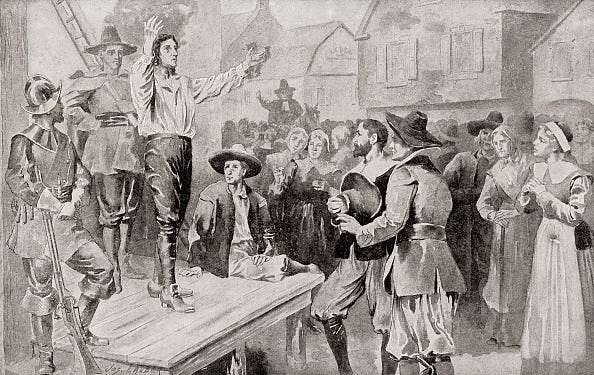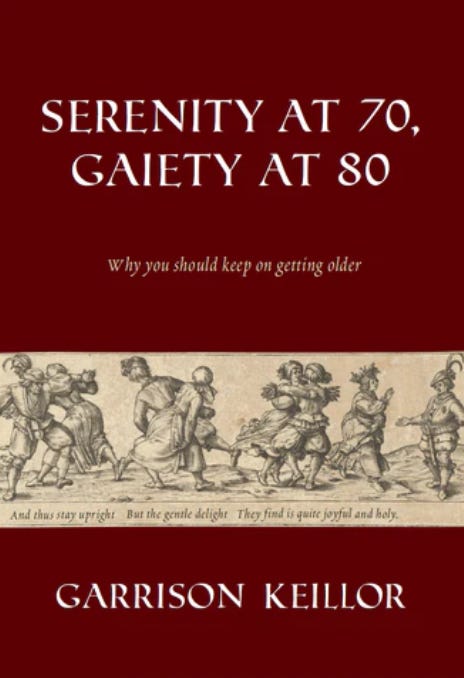“Before the Blight” by Ruth Stone from What Love Comes To. © 2002 by Ruth Stone. Used with the permission of The Permissions Company, Inc., on behalf of Copper Canyon Press.
ORIGINAL TEXT AND AUDIO - 2017
On this day in 1692, the Court of Oyer and Terminer convened in Salem Town, Massachusetts, beginning what would become known as the Salem Witch Trials. The hysteria had begun in Salem Village (now Danvers, Massachusetts) in January of that year; a few preteen and teenage girls, including the daughter of Samuel Parris, the village's minister, began acting strangely and having fits, insisting that they were being poked and pinched. The local doctor was at a loss to explain the behavior, and concluded that they must be bewitched. When the girls were pressured to name their tormentors, they blamed Tituba, the Parrises' Caribbean slave, and two eccentric social outcasts, Sarah Good and Sarah Osborne. Paranoia mounted, with more teenage girls suddenly joining the ranks of the afflicted; they were no longer expected to be "seen and not heard," but were now the center of attention, even crying out and disrupting church meetings without being punished. They began accusing reputable churchgoers, often people their parents had feuded with for years. Alibis were useless because the afflicted girls would say that the accused had sent her specter to torment them, and anyone who spoke out against the proceedings soon found the accusing fingers pointing at them.
Within a matter of weeks, warrants were issued for dozens of accused witches, and the jails were full to bursting. Governor William Phipps ordered the formation of the Special Court of Oyer and Terminer — which meant "to hear and determine" — to try the backlog of cases. The first case brought before the grand jury was that of Bridget Bishop, a tavern owner, who had attracted the negative attention by virtue of the fact that she played shuffleboard and dressed in unsuitable clothing. She was found guilty and sentenced to hang on June 10, the first of 19 executions that took place over the next four months. A 20th victim, Giles Cory, was tortured to death when he refused to enter a plea. The hysteria spread to nearby towns, and feuding neighbors began to see it as a handy way to get revenge. Many of the accused people confessed to witchcraft to escape execution, because confession meant you were repentant, and it was up to God to handle your punishment. Those who refused to confess — either on moral grounds or because confession meant they would forfeit their property — were executed.
In October, Governor Phipps abruptly dissolved the Court of Oyer and Terminer and prohibited further arrests, maybe because Puritan ministers were calling for an end to the trials, or maybe because the afflicted girls had accused Phipps's wife of witchcraft. Over an eight-month period, more than 200 people had been accused and imprisoned, and several had died in jail. Some of the judges and examiners later expressed remorse. Examiner John Hale wrote in 1695, "Such was the darkness of the day, and so great the lamentations of the afflicted, that we walked in the clouds and could not see our way."
Today is the birthday of the man who said, "The business of the poet and the novelist is to show the sorriness underlying the grandest things and the grandeur underlying the sorriest things." English novelist and poet Thomas Hardy was born on this day in Higher Bockhampton, Dorset, in 1840. He often helped his father with various building projects, and when he was 16, he took a job as an architect's apprentice. He moved to London when he was 22, to take a job with another architect, and he delighted in the city's literary and cultural environment. He began writing fiction and poetry; his first published story was "How I Built Myself a House" (1865), and he also wrote a novel, The Poor Man and the Lady (1867), which was never published.
He set many of his novels and poems in "Wessex," reviving the old Anglo-Saxon name for the counties of southwestern England, where he grew up. The Wessex he wrote of, though, was part real place, part literary conceit; he always insisted, "This is an imaginative Wessex only."
His first commercial and critical success was Far From the Madding Crowd (1874); it did so well that he was able to quit architecture and write full time. He produced six novels in the 1880s, and seven in the 1890s; two of these — Tess of the D'Urbervilles (1891) and Jude the Obscure (1895) — caused so much scandal that he eventually gave up on novels forever. He wrote a few plays, but in the end he returned to his first love — poetry — which he regarded as a purer art form anyway. He produced eight collections before his death in 1928. He had two funerals simultaneously: His cremated remains were buried in Poets' Corner in Westminster Abbey, while at the same time, his heart was buried in Dorchester, in his beloved Wessex.
From his poem "Wessex Heights" (1896):
There are some heights in Wessex, shaped as if by a kindly hand
For thinking, dreaming, dying on, and at crises when I stand,
Say, on Ingpen Beacon eastward, or on Wylls-Neck westwardly,
I seem where I was before my birth, and after death may be.






I am mates with a local poet who resides in southern England, Dorset to be exact. His name is Scott Hastie. I think I will forward him this post. I never read Thomas Hardy's oeuvre but I am familiar with his titles. My friend Chris has visited Salem, MA during the Halloween season. I speculate one of my ex girlfriends was a witch on Cape Cod. it could be pure heresy.
I missed somwhow the explanation of why the wrters almanac is usung 2017 postings???